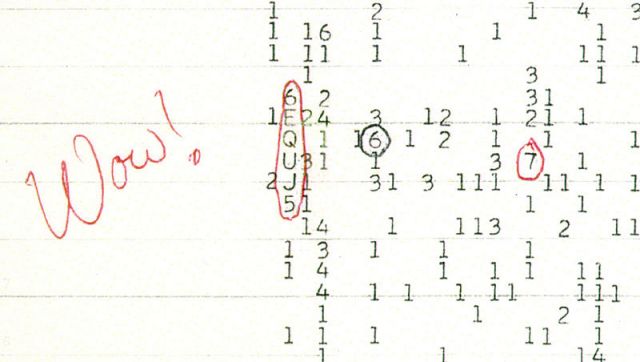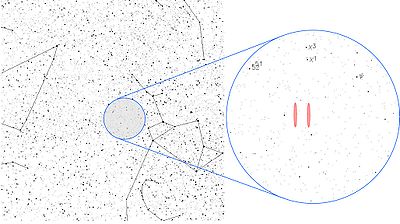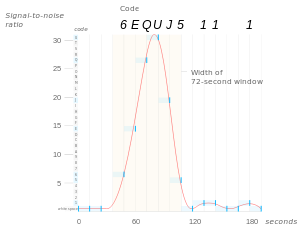| Online: | |
| Visits: | |
| Stories: |

| Story Views | |
| Now: | |
| Last Hour: | |
| Last 24 Hours: | |
| Total: | |
Alien Contact – “The Wow Signal” – Space Signal Received by SETI

The Wow! signal was a strong narrowband radio signal detected by Jerry R. Ehman on August 15, 1977, while he was working on a SETI project at the Big Ear radio telescope of The Ohio State University, then located at Ohio Wesleyan University’s Perkins Observatory in Delaware, Ohio. The signal bore the expected hallmarks of non-terrestrial and non-Solar System origin. It lasted for the full 72-second window that Big Ear was able to observe it, but has not been detected again. The signal has been the subject of significant media attention.
Amazed at how closely the signal matched the expected signature of an interstellar signal in the antenna used, Ehman circled the signal on the computer printout and wrote the comment “Wow!” on its side. This comment became the name of the signal
The circled alphanumeric code 6EQUJ5 describes the intensity variation of the signal. A space denotes an intensity between 0 and 1, the numbers 1 to 9 denote the correspondingly numbered intensities (from 1.0 to 10.0), and intensities of 10.0 and above are denoted by a letter (‘A’ corresponds to intensities between 10.0 and 11.0, ‘B’ to 11.0 to 12.0, etc.). The value ‘U’ (an intensity between 30.0 and 31.0) was the highest detected by the radio telescope; on a linear scale it was over 30 times louder than normal deep space. The intensity in this case is the unitless signal-to-noise ratio, where noise was averaged for that band over the previous few minutes.
Two different values for its frequency have been given: 1420.356 MHz (J. D. Kraus) and 1420.4556 MHz (J. R. Ehman). The frequency of the Wow! signal matches very closely with the hydrogen line, which is at 1420.40575177 MHz. The hydrogen line frequency is significant for SETI searchers because, it is reasoned, hydrogen is the most common element in the universe, and hydrogen resonates at about 1420.40575177 MHz, so extraterrestrials might use that frequency to transmit a strong signal. The two different values given for the frequency of the Wow! signal (1420.356 MHz and 1420.4556 MHz) are the same distance apart from the hydrogen line—the first being about 0.0498 MHz (49.75177 KHz) less than the hydrogen line, and the second about 0.0498 MHz (49.84823 KHz) more. The bandwidth of the signal is less than 10 kHz (each column on the printout corresponds to a 10 kHz-wide channel; the signal is only present in one column).
The location of the signal in the constellation Sagittarius, near the Chi Sagittarii star group. Because of the design of the experiment, the location may lie in either one of the two red bands, and there is also significant uncertainty in the declination (vertical axis). For clarity, the widths of the red bands are not drawn to scale; they should actually be narrower.
The original printout of the Wow! signal, complete with Jerry Ehman’s famous exclamation, is preserved by the Ohio Historical Society
Determining a precise location in the sky was complicated by the Big Ear telescope’s use of two feed horns to search for signals, each pointing to a slightly different direction in the sky following Earth’s rotation; the Wow! signal was detected in one of the horns but not in the other, and the data was processed in such a way that it is impossible to determine which of the two horns the signal entered. There are, therefore, two possible right ascension values:
19h22m24.64s ± 5s (positive horn)
19h25m17.01s ± 5s (negative horn)
The declination was unambiguously determined to be −27°03′ ± 20′. The preceding values are all expressed in terms of the B1950.0 equinox.
Converted into the J2000.0 equinox, the coordinates become RA= 19h25m31s ± 10s or 19h28m22s ± 10s and the declination becomes −26°57′ ± 20′.
This region of the sky lies in the constellation Sagittarius, roughly 2.5 degrees south of the fifth-magnitude star group Chi Sagittarii, and about 3.5 degrees south of the plane of the ecliptic. Tau Sagittarii is the closest easily visible star.
The Big Ear telescope was fixed and used the rotation of the Earth to scan the sky. At the speed of the Earth’s rotation, and given the width of the Big Ear’s observation “window”, the Big Ear could observe any given point for just 72 seconds. A continuous extraterrestrial signal, therefore, would be expected to register for exactly 72 seconds, and the recorded intensity of that signal would show a gradual increase for the first 36 seconds—peaking when the signal reached the center of Big Ear’s observation “window”— and then a gradual decrease.
Therefore, both the length of the Wow! signal, 72 seconds, and the shape of the intensity graph may correspond to an extraterrestrial origin
The signal was expected to appear three minutes apart in each of the horns, but that did not happen. Ehman unsuccessfully looked for recurrences of the signal using Big Ear in the months after the detection.

In 1987 and 1989, Robert H. Gray searched for the event using the META array at Oak Ridge Observatory, but did not detect it.
In a July 1995 test of signal detection software to be used in its upcoming Project Argus search, SETI League executive director H. Paul Shuch made several drift-scan observations of the Wow! signal’s coordinates with a 12-meter radio telescope at the National Radio Astronomy Observatory in Green Bank, West Virginia, also achieving a null result.
In 1995 and 1996, Gray also searched for the signal using the Very Large Array, which is significantly more sensitive than Big Ear.
Gray and Simon Ellingsen later searched for recurrences of the event in 1999 using the 26m radio telescope at the University of Tasmania’s Mount Pleasant Radio Observatory. Six 14-hour observations were made at positions in the vicinity, but nothing like the Wow! signal was detected.
Interstellar scintillation of a weaker continuous signal—similar in effect to atmospheric twinkling—could be an explanation, but that would not exclude the possibility of the signal being artificial in origin. But even the significantly more sensitive Very Large Array could not detect the signal, and the probability that a signal below the Very Large Array level could be detected by the Big Ear due to interstellar scintillation is low. Other speculations include a rotating lighthouse-like source, a signal sweeping in frequency, or a one-time burst.
Ehman has voiced doubts that the signal was of intelligent extraterrestrial origin: “We should have seen it again when we looked for it 50 times. Something suggests it was an Earth-sourced signal that simply got reflected off a piece of space debris.” He later recanted his skepticism somewhat, after further research showed an Earth-borne signal to be very unlikely, given the requirements of a space-borne reflector being bound to certain unrealistic requirements to sufficiently explain the signal. Also, the 1420 MHz signal is problematic in itself in that it is “protected spectrum”: bandwidth reserved for astronomical purposes in which terrestrial transmitters are forbidden to transmit. In his most recent writings, Ehman resists “drawing vast conclusions from half-vast data”—acknowledging the possibility that the source may have been military or otherwise a product of Earth-bound humans.
Scientists say that if the signal came from extraterrestrials, they are likely to be an extremely advanced civilization, as the signal would have required a 2.2-gigawatt (2,200,000 kW) transmitter, vastly more powerful than any on Earth: the Earth transmitters with the highest power are the Taldom transmitter at 2500 kW in long wave and the Bolshakovo transmitter at 2500 kW in medium wave.
In 2012, on the 35th anniversary of the Wow! signal, Arecibo Observatory beamed a response from humanity, containing 10,000 Twitter messages, in the direction from which the signal originated. In the response, Arecibo scientists have attempted to increase the chances of intelligent life receiving and decoding the celebrity videos and crowd-sourced tweets by attaching a repeating sequence header to each message that will let the recipient know that the messages are intentional and from another intelligent life form





Oooooooooooooooold news.
This has been around on this site for years and years.
Indeed, quite true. And while I do appreciate the author’s work in composing the article, in the long run, SETI is nothing more than a counterintelligence operation. What better way to deny the truth than to say that we are “looking for it”. Gee, they somehow missed this:
http://www.upwardvectorpubs.com/61ufox.htm
And they seem to have completely missed what happened at Roswell also:
http://www.upwardvectorpubs.com/62lofd1.htm
http://www.upwardvectorpubs.com/62lofd2.htm
http://www.upwardvectorpubs.com/62lofd3.htm
Well, I didn’t miss what happened at Roswell…
Never before released data about Roswell in this video:
Above Top Secret – Past Life Memories on other Planets
https://www.youtube.com/watch?v=4T3KXBD-A0Q
Wow who cares
I enjoy all your stories, In the Bible it talks about THE NEW WORLD ORDER, and UFO, and Armegetion, it’s where they will kill Whites, Christians, Jews off. I loved it , very interesting, you always do a good job, I APPREACATE YOUR WORK>



